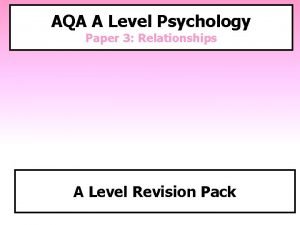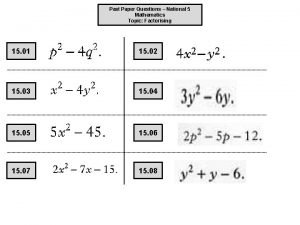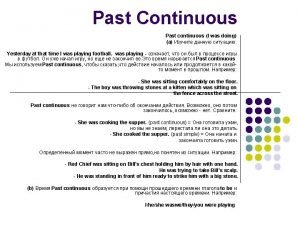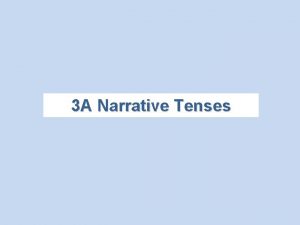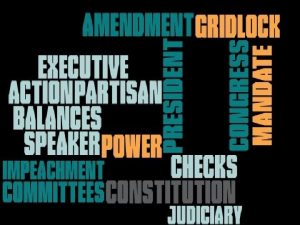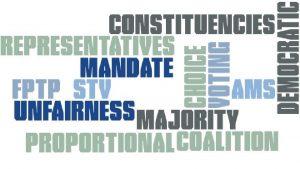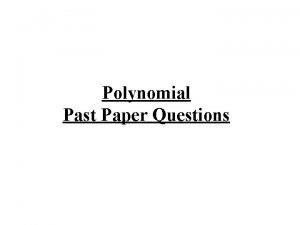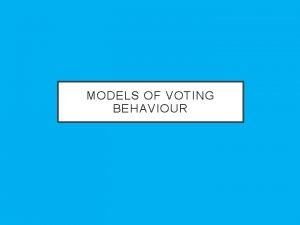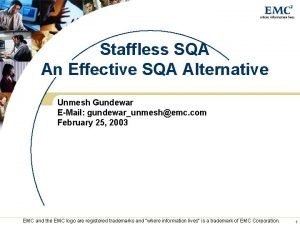HIGHER PAST PAPER QUESTIONS SQA 2018 Specimen Paper
























- Slides: 24


HIGHER PAST PAPER QUESTIONS SQA 2018 Specimen Paper To what extent is age the most influential factor on voting behaviour? You should refer to Scotland or the United Kingdom or both in your answer. (20) SQA 2018 Analyse the influence of the media on voting behaviour. You should refer to voting behaviour in Scotland or the United Kingdom or both in your answer. (20) SQA 2015 “Some factors are more important than others in influencing voting behaviour. “ To what extent are some factors more important than others in influencing voting behaviour?

Voting behaviour is complex. There are numerous factors at work; some long term, some short term. Scotland has a completely different voting behaviour model to England. SOME CONCLUSIONS Long term influences such as social class, gender, race and age are still influential. Shorter term influences, such as media/leadership, party campaigns and key policies are also important. Older voters have different priorities than younger voters. Brexit was a key issue in UKGE 2019.




PARTY CAMPAIGN: THE AIR WAR • Parties who do well in elections have successful media campaigns; in the mainstream media (MSM); television, radio and newspapers and, increasingly, social media. • In the 2017 General Election, Labour did much better than expected. This was, in part, due to its campaigning in the media. • Labour dominated the digital election because the party used Facebook, Twitter and online videos to build and motivate its voter base, rather than to attack the Conservatives. 2017 Labour campaign video

PARTY CAMPAIGN: THE AIR WAR Labour, however, did badly in the air war in 2019. This wasn’t because it didn’t know how to use social media but because it didn’t have a clear message. The 2019 UK General Election was a single issue election, about Brexit. Labour’s message was complicated because the party itself was divided over what it felt about Brexit. By contrast, the Conservatives’ message was clear. Get Brexit Done

VOTING BY MEME? • The Guardian newspaper ran an experiment to record the smartphone screens of volunteers. • It found that some people consumed their news almost entirely through headlines. Few clicked through to the full article, and those that read to the end of a piece were a rarity. • In this snapshot of online voter behaviour, news was often consumed through user-generated memes, posts by celebrity influencers, and politicians’ own social media accounts. • Posts by comedians such as Jason Manford were as likely to decide what people see online about the election as stories from traditional news outlets.

FACTOR: THE MEDIA Newspapers can be as partisan as they like. In the 2019 General Election, the majority of newspapers, the biggest selling ones in the UK, backed the Conservatives. No one knows for sure how influential they are, but all the political parties want their support. But in the social media age, political parties and their supporters can, to some extent, bypass traditional media and reach voters via their phones and tablets. It’s not a matter of mainstream media v social media in terms of influence. The two are related. Parties campaign on both. Newspapers campaign on both.

THE INTEGRATION OF THE MSM AND SOCIAL MEDIA Many voters engage with both forms of media at the same time. This explain why political parties seek to co-ordinate their social media messages.

THE CHICKEN OR THE EGG? Do newspapers influence readers or do readers buy newspapers which reflect their outlook on life?

PARTY CAMPAIGN: THE GROUND WAR • The SNP is Scotland’s largest political party. • It has more members than any other party and better IT software which can identify voters likely to vote SNP and get them out to vote; the ground war. • Around 30% of voters do not vote in UK and Scottish elections. Just getting those who support you, rather than debating with those who do not, out the door to vote can be as important as a successful air war. • An effective air war supported by a professional ground war is, of course, the perfect combination! SNP ground war

FACTOR: SOCIAL CLASS • Social class remains a factor in voting behaviour. The First Past the Post voting system reflects the class divide in society. Some constituencies are solidly middle class and affluent; and more likely to be won by the Conservatives and others are working class and less affluent and more likely to be won by the SNP or Labour. • These two Scottish parliamentary seats border one another. These were the results in the 2016 Scottish parliament constituency elections. (Source: Democratic Dashboard) Eastwood Glasgow Pollok

AFFLUENT EASTWOOD

LESS AFFLUENT GLASGOW POLLOK

FACTOR: SOCIAL CLASS Social class is clearly a factor in how people vote, but its influence is changing. What has been noticeable in recent elections is how the Conservative Party has increased its share of the vote among traditional Labour voters.

FACTOR: SOCIAL CLASS Conservative policies, such as cutting welfare payments, leaving the EU and limiting immigration may have an appeal for lower income voters who resent the ‘workshy’ and are fearful of losing their jobs to EU and non-EU immigrants. Better-educated people are now more likely to vote for “Left-wing” parties or centrist causes, while those who never went to university are more likely to vote for “Rightwing” or populist parties. The Labour party is increasingly appealing to educated, cosmopolitan city dwellers, rather than its ‘traditional’ working class. Are the Tories the party of the working class?

BEATING DOWN THE RED WALL In 2019 the Conservatives actually did better than Labour did among poorer voters. This may have been a one off due to Brexit, and the data obscures what happened in Scotland, where the SNP was most popular, but it confirms a long term trend that working class voters in England no longer see Labour as their ‘natural’ party. Source: IPSOS MORI Beating down the red wall

FACTOR: AGE Age seems to be the new dividing line in British politics. In 2019, the older the age group was the more it voted Conservative. The opposite was the case for Labour. Reasons? Partly social, partly economic. Source: IPSOS MORI

FACTOR: GENDER In 2019, as in other recent elections, there was no real significant gender difference in voting behaviour, with both male and female voters backing the Conservatives. Source: IPSOS MORI

FACTOR: AGE • Younger people find it more difficult to get on the property ladder than older generations. • They have debts. • They are better qualified than previous generations but find it harder to get well paid, secure jobs. • They are having to work longer hours and for longer years. • Many work for zero hours contracts, on minimum wage or worse. Little wonder they want change. • By contrast, many retired voters had the benefit of the pre-austerity years; money in the bank, equity in their houses, good pensions and high living standards. Little wonder they do not want change. • The theory of advancing years and social/economic conservatism would appear to apply to some extent with the Scottish independence referendum and the EU referendum. • 60% of those aged 65 or older voted to leave the EU. 73% of 18 to 24 year-olds voted to remain. Age and 2017

FACTOR: THE CONSTITUTION The SNP remains Scotland’s largest party and the constitutional issue is a huge factor in Scottish voting behaviour. Scotland increasingly has different social and economic policies from the rest of the UK. What is popular in the rest of the UK, Brexit being one example, is not necessarily popular in Scotland. Hence, Scotland has a very different voting model. The SNP has become a ‘catch all’ political party across the Left and Right. The Scottish Conservatives have regained traditional middle class voters who dislike Scottish independence largely for economic reasons and some working class voters who dislike Scottish independence for cultural reasons. Like it or not, the constitutional question isn’t going away. Scotland’s voting behaviour

FACTOR: RACE Traditionally the Conservatives have struggled to win the support of ethnic minorities. The party’s reputation as the ‘nasty party’, as indifferent to the needs of ethnic minority have been hard for the party to escape from. This is despite the affluence of many minority voters and the Conservatives having high profile minority representatives. In 2019, Labour continued to appeal more to black and minority ethnic voters. 64% of BME voters voted Labour, compared to just 20% who voted Conservatives and BME voters
 Higher biology unit 2 past paper questions
Higher biology unit 2 past paper questions Advanced higher geography study
Advanced higher geography study Understanding standards advanced higher english
Understanding standards advanced higher english Advanced higher computing
Advanced higher computing Higher photography
Higher photography Understanding standards media
Understanding standards media Understanding standards psychology
Understanding standards psychology Understanding standards advanced higher geography
Understanding standards advanced higher geography Economics paper 3 aqa
Economics paper 3 aqa What inspired carol ann duffy to write war photographer
What inspired carol ann duffy to write war photographer Sqa economics past papers
Sqa economics past papers Dada la siguiente secuencia rusia 2018 rusia 2018
Dada la siguiente secuencia rusia 2018 rusia 2018 Absorption addiction model
Absorption addiction model All my sons exam questions
All my sons exam questions Past paper questions
Past paper questions Factorising questions nat 5
Factorising questions nat 5 Key stage 1 reasoning paper 2018
Key stage 1 reasoning paper 2018 Past simple past continuous past perfect exercises
Past simple past continuous past perfect exercises Past continuous vs past perfect simple
Past continuous vs past perfect simple Past perfect past continuous past simple
Past perfect past continuous past simple Past perfect and past continuous
Past perfect and past continuous паст перфект как образуется
паст перфект как образуется Narrative tenses past simple past perfect past continuous
Narrative tenses past simple past perfect past continuous Past simple past continuous past perfect
Past simple past continuous past perfect Past simple, past continuous, present perfect
Past simple, past continuous, present perfect












